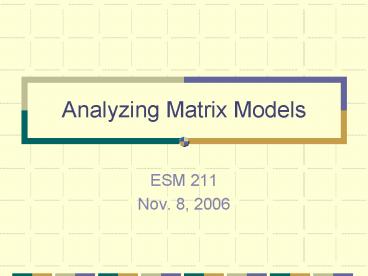Analyzing Matrix Models - PowerPoint PPT Presentation
1 / 35
Title: Analyzing Matrix Models
1
Analyzing Matrix Models
- ESM 211
- Nov. 8, 2006
2
Projecting the model
- Semipalmated Sandpiper in Manitoba
- Three age classes
- Initial age distribution (/ha)
- Projection matrix
- Iterate the model
3
(No Transcript)
4
(No Transcript)
5
(No Transcript)
6
Asymptotic growth rate
- When population reaches stable age (or size or
stage) distribution then all classes grow (or
decline) at the same rate
lambda_1 0.6389479 Class Stable
distribution Reproductive value 1
0.1188640 1 2
0.1047353 1.097332 3
0.7764007 1.113922
7
Matrices and growth rate
- The asymptotic growth rate (l1) is the dominant
eigenvalue of the projection matrix - The stable age distribution (w1) is the
associated right eigenvector - The reproductive value distribution (v1) is the
associated left eigenvector
8
What good is a deterministic matrix model?
- Assumes that the environment is constant
unrealistic! But - If lambda lt 1, population is really in trouble!
- We might not have info on temporal variability
- Insights from sensitivity analysis (next) carry
over to stochastic case
9
Sensitivity Elasticity
- Sensitivity absolute rate of change of l1 with
respect to absolute change in a matrix element - Elasticity relative rate of change of l1 with
respect to relative change in a matrix element
10
Sensitivity Elasticity of vital rates
11
Sensitivity in management
- For each potential mgmt action
- Define its effect on demography (e.g. reduce
mortality of adults) - Estimate cost per unit effort
- Use sensitivity or elasticity to find improvement
in lambda per unit cost
12
Sea turtle conservation
- All 5 US species are endangered
- Current densities may be only 1 of pre-European
values - Populations declining at up to 5 per year
- How can we reverse sea turtle population decline?
13
Sea turtle life history
- Eggs laid on beaches, clutches buried in sand
- Hatchlings emerge and enter sea
- 30 years to reach reproductive maturity
14
Anthropogenic threats
- Eggs preyed on and accidentally destroyed by
humans - Hatchlings disoriented by bright lights
- Hatchlings get stuck in vehicle tracks
- Juveniles and adults get caught in fishing gear,
especially shrimp trawls
15
Protection strategies
- Protect eggs and hatchlings 20-30 years of
aggressive efforts had little effect - Install turtle excluder devices (TEDs) on shrimp
trawls unpopular with fishermen -- politically
costly
16
Stage-structured sea turtle model
17
Sea turtle elasticities
18
Predicted growth rates
19
Effects of vital rate uncertainty
20
Environmental stochasticity 1
- Construct a projection matrix for each year
- Simulate the population by drawing one of the
matrices for each simulation year - Run lots of replicate simulations etc.
21
Environmental stochasticity 2
- Estimate the means, variances, and covariances of
vital rates - Calculate the stochastic log growth rate
22
Environmental stochasticity 3
- Estimate the means, variances, and covariances of
vital rates - For each simulation year, draw vital rates at
random construct matrix for that year - 0-1 parameters use Beta distribution
- Fertility lacking other info, use log-normal
- Run replicate simulations etc.
23
Stochastic simulations with demographic
stochasticity
- For each individual, draw random numbers to
determine fate, with parameter given by the
corresponding mean vital rate - Survival binomial
- Growth sequence of binomials
- Fecundity Poisson?
24
Growth rates
- Sampling distribution of growth transitions is
multinomial - Treat as a sequence of binomial processes
25
Adding environmental stochasticity
- Estimate among-year variance covariance in
vital rates from data - Each simulation year, the mean vital rate is
drawn at random - Binomial variables Use beta distribution
- Fertility lacking other info, use log-normal
- Simulate demographic stochasticity in that year
using that rate
26
Estimating variance in demographic rates
- Some of the among-year variance in observed
demography will be due to sampling error - Need to correct for this
- First cut similar approach as for count-based
PVA
27
Simple variance correction
28
More sophisticated approach
- Solve the following for Vc
- Find CI by replacing 1 in eqn above with
29
Sensitivity again What we really want to know
- Sensitivities of
- Stochastic growth rate
- Extinction time under demographic stochasticity
- Extinction time under environmental stochasticity
- Equilibrium density under density dependence
- Invasion speed
30
What does sensitivity of l tell us about all this?
- Nothing, directly
- But it might tell us something about the
sensitivity of those quantities to various stages
in the life history - Caswell compare sensitivity of l to sensitivity
of quantities of interest
31
Sensitivity of stochastic growth rate
- Build a model with demographic stochasticity
- Run model for many iterations, and calculate
long-term growth rate - Change one stage specific parameter, and re-run
the model - Change in long-term growth rate is its
sensitivity to that parameter
32
Sensitivity of stochastic growth rate (2)
- Build a matrix model with same stage transitions
and parameter values - Calculate sensitivities of l to each parameter
- Compare with sensitivities from previous slide
33
Sensitivity of stochastic growth rate (3)
- Sensitivity of l strongly correlated with
sensitivity of stochastic growth rate - element with large effect on l also has large
effect on stochastic growth rate - Similarly, sensitivity of l strongly correlated
with sensitivity of - extinction time
- equilibrium density
- invasion speed
34
Caveats of Caswells work
- Based on perfect knowledge
- e.g., for environmental stochasticity, analysis
of l based on average matrix, where average is
taken over all the generations of the stochastic
simulation - Important question how many years of data
required for this approach to work?
35
Some analytics































